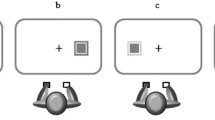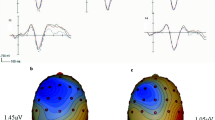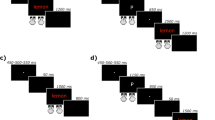Abstract
We conducted an event-related potential (ERP) study to investigate the electrocortical dynamics of attentional feature-based processing in the Stroop matching task. Participants in the study (n = 37) compared the ink color of a colored word with the meaning of a color–word in white ink. The two task stimuli were presented simultaneously or with SOAs (Stimulus Onset Asynchrony) of 400 and 1,200 ms. The Stroop matching effect was maximal during SOA-0, was reduced at SOA-400, and was inverted at SOA-1200. We focused the ERP analysis on the N1 component. Paralleling the behavioral results, the N1 amplitude was greater for congruent stimuli than incongruent stimuli during SOA-0. This difference was attenuated at SOA-400, and at SOA-1200, an inverse pattern was observed. The results provide evidence that early selection processing participated in the Stroop matching task phenomenon and also suggest that the temporal modulation of early attention is a function of task characteristics such as SOA.




Similar content being viewed by others
References
Akyurek EG, Dinkelbach A, Schubo A, Muller HJ (2010a) Electrophysiological correlates of detecting a visual target and detecting its absence: the role of feature dimensions. Neuropsychologia 48:3365–3370
Akyurek EG, Schubo A, Hommel B (2010b) Fast temporal event integration in the visual domain demonstrated by event-related potentials. Psychophysiology 47:512–522
Anllo-Vento L, Hillyard SA (1996) Selective attention to the color and direction of moving stimuli: electrophysiological correlates of hierarchical feature selection. Percept Psychophys 58:191–206
Anllo-Vento L, Luck SJ, Hillyard SA (1998) Spatio-temporal dynamics of attention to color: evidence from human electrophysiology. Hum Brain Mapp 6:216–238
Appelbaum LG, Meyerhoff KL, Woldorff MG (2009) Priming and backward influences in the human brain: processing interactions during the stroop interference effect. Cereb Cortex 19:2508–2521
Atkinson CM, Drysdale KA, Fulham WR (2003) Event-related potentials to stroop and reverse stroop stimuli. Int J Psychophysiol 47:1–21
Botvinick M, Nystrom LE, Fissell K, Carter CS, Cohen JD (1999) Conflict monitoring versus selection-for-action in anterior cingulate cortex. Nature 402:179–181
Botvinick MM, Braver TS, Barch DM, Carter CS, Cohen JD (2001) Conflict monitoring and cognitive control. Psychol Rev 108:624–652
Delorme A, Makeig S (2004) EEGLAB: an open source toolbox for analysis of single-trial EEG dynamics including independent component analysis. J Neurosci Methods 134:9–21
Durgin FH (2003) Translation and competition among internal representations in a reverse Stroop effect. Percept Psychophys 65:367–378
Dyer FN (1971) The duration of word meaning responses: Stroop interference for a different preexposures of the word. Psychon Sci 25:229–231
Dyer FN (1973) Same and different judgments for word-color pairs with “irrelevant” words or colors: evidence for word-code comparisons. J Exp Psychol 98:102–108
Flowers JH (1975) “Sensory” interference in a word-color matching task. Percept Psychophys 18:37–43
Glaser M, Glaser W (1982) Time course analysis of the stroop phenomenon. J Exp Psychol 8:875–895
Glaser WR, Glaser MO (1989) Context effects in stroop-like word and picture processing. J Exp Psychol Gen 118:13–42
Goldfarb L, Henik A (2006) New data analysis of the stroop matching task calls for a reevaluation of theory. Psychol Sci 17:96–100
Goldfarb L, Henik A (2007) Evidence for task conflict in the stroop effect. J Exp Psychol Hum Percept Perform 33:1170–1176
Hanslmayr S, Pastotter B, Bauml KH, Gruber S, Wimber M, Klimesch W (2008) The electrophysiological dynamics of interference during the stroop task. J Cogn Neurosci 20:215–225
Hillyard SA, Munte TF (1984) Selective attention to color and location: an analysis with event-related brain potentials. Percept Psychophys 36:185–198
Ilan AB, Polich J (1999) P300 and response time from a manual Stroop task. Clin Neurophysiol 110:367–373
Jung TP, Makeig S, Humphries C, Lee TW, McKeown MJ, Iragui V, Sejnowski TJ (2000) Removing electroencephalographic artifacts by blind source separation. Psychophysiology 37:163–178
Keil A, Muller MM (2010) Feature selection in the human brain: electrophysiological correlates of sensory enhancement and feature integration. Brain Res 1313:172–184
Keil A, Smith JC, Wangelin BC, Sabatinelli D, Bradley MM, Lang PJ (2008) Electrocortical and electrodermal responses covary as a function of emotional arousal: a single-trial analysis. Psychophysiology 45:516–523
Kopp B, Tabeling S, Moschner C, Wessel K (2007) Temporal dynamics of selective attention and conflict resolution during cross-dimensional Go-NoGo decisions. BMC Neurosci 8:68
Liotti M, Woldorff MG, Perez R, Mayberg HS (2000) An ERP study of the temporal course of the stroop color-word interference effect. Neuropsychologia 38:701–711
Liu X, Banich MT, Jacobson BL, Tanabe JL (2006) Functional dissociation of attentional selection within PFC: response and non-response related aspects of attentional selection as ascertained by fMRI. Cereb Cortex 16:827–834
Luo CR (1999) Semantic competition as the basis of stroop interference: evidence from color-word matching task. Psychol Sci 10:35–40
Machado-Pinheiro W, Volchan E, Vila J, Dias EC, Alfradique I, Oliveira L, Pereira MG, David IA (2010) Role of attention and translation in conflict resolution: implications for Stroop matching task interference. Psychol Neurosci. Reference type: In press
MacLeod CM, MacDonald PA (2000) Interdimensional interference in the stroop effect: uncovering the cognitive and neural anatomy of attention. Trends Cogn Sci 4:383–391
Mangun GR (1995) Neural mechanisms of visual selective attention. Psychophysiology 32:4–18
Markela-Lerenc J, Ille N, Kaiser S, Fiedler P, Mundt C, Weisbrod M (2004) Prefrontal-cingulate activation during executive control: which comes first? Brain Res Cogn Brain Res 18:278–287
Mascolo MF, Hirtle SC (1990) Verbal coding and the elimination of stroop interference in a matching task. Am J Psychol 103:195–215
Milham MP, Banich MT (2005) Anterior cingulate cortex: an fMRI analysis of conflict specificity and functional differentiation. Hum Brain Mapp 25:328–335
Mitchell RL (2006) Anterior cingulate activity and level of cognitive conflict: explicit comparisons. Behav Neurosci 120:1395–1401
Polk TA, Drake RM, Jonides JJ, Smith MR, Smith EE (2008) Attention enhances the neural processing of relevant features and suppresses the processing of irrelevant features in humans: a functional magnetic resonance imaging study of the stroop task. J Neurosci 28:13786–13792
Rebai M, Bernard C, Lannou J (1997) The stroop’s test evokes a negative brain potential, the N400. Int J Neurosci 91:85–94
Schoenfeld MA, Hopf JM, Martinez A, Mai HM, Sattler C, Gasde A, Heinze HJ, Hillyard SA (2007) Spatio-temporal analysis of feature-based attention. Cereb Cortex 17:2468–2477
Silton RL, Heller W, Towers DN, Engels AS, Spielberg JM, Edgar JC, Sass SM, Stewart JL, Sutton BP, Banich MT, Miller GA (2010) The time course of activity in dorsolateral prefrontal cortex and anterior cingulate cortex during top-down attentional control. Neuroimage 50:1292–1302
Simon JR, Baker KL (1995) Effect of irrelevant information on the time to enter and retrieve relevant information in a stroop-type task. J Exp Psychol 21:1028–1043
Simon JR, Berbaum K (1988) Effect of irrelevant information on retrieval time for relevant information. Acta Psychol 67:33–57
Slotnick SD, Schwarzbach J, Yantis S (2003) Attentional inhibition of visual processing in human striate and extra striate cortex. Neuroimage 19:1602–1611
Smid HG, Jakob A, Heinze HJ (1999) An event-related brain potential study of visual selective attention to conjunctions of color and shape. Psychophysiology 36:264–279
Stroop JR (1935) Studies of interference in serial verbal reactions. J Exp Psychol 18:643–663
Sugg MJ, McDonald JE (1994) Time course of inhibition in color-response and word-response versions of the stroop task. J Exp Psychol Hum Percept Perform 20:647–675
Treisman A, Fearnley S (1969) The stroop test: selective attention to colours and words. Nature 222:437–439
Virzi RA, Egeth HE (1985) Toward a translational model of stroop interference. Mem Cognit 13:304–319
Vogel EK, Luck SJ (2000) The visual N1 component as an index of a discrimination process. Psychophysiology 37:190–203
West R, Alain C (1999) Event-related neural activity associated with the stroop task. Cogn Brain Res 8:157–164
West R, Bowry R, McConville C (2004) Sensitivity of medial frontal cortex to response and nonresponse conflict. Psychophysiology 41:739–748
Woldorff MG (1993) Distortion of ERP averages due to overlap from temporally adjacent ERPs: analysis and correction. Psychophysiology 30:98–119
Wuhr P, Waszak F (2003) Object-based attentional selection can modulate the stroop effect. Mem Cognit 31:983–994
Zhang W, Luck SJ (2009) Feature-based attention modulates feed forward visual processing. Nat Neurosci 12:24–25
Zysset S, Muller K, Lohmann G, von Cramon DY (2001) Color-word matching stroop task: separating interference and response conflict. Neuroimage 13:29–36
Acknowledgments
This research was supported by Fundação Carlos Chagas Filho de Amparo à Pesquisa do Estado do Rio de Janeiro, Conselho Nacional de Desenvolvimento Científico e Tecnológico (CNPq), and Coordenação de Aperfeiçoamento de Pessoal de Nível Superior (CAPES). Partial support was also provided by grants from IBNNet/FINEP and PROPP-UFF. We extend special thanks to the Society for Psychophysiological Research (SPR) for the fellowship training program to the first author (IAD).
Author information
Authors and Affiliations
Corresponding author
Rights and permissions
About this article
Cite this article
David, I.A., Volchan, E., Vila, J. et al. Stroop matching task: role of feature selection and temporal modulation. Exp Brain Res 208, 595–605 (2011). https://doi.org/10.1007/s00221-010-2507-9
Received:
Accepted:
Published:
Issue Date:
DOI: https://doi.org/10.1007/s00221-010-2507-9




